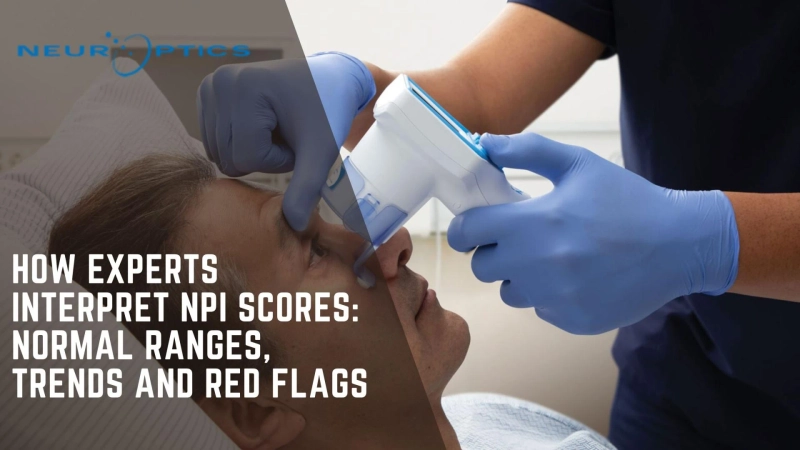Understanding the NPI or the Neurological Pupil index is mandatory for neuro tests and critical care decisions. This blog dives into the details of how experts interpret NPi scores with automated pupilometers from Neuroptics. It is important to know how to track trends and what red flags mean serious neurological decline. Get practical insights into pupil measurement and reactivity in ICU and emergency settings.
Introduction
Pupil assessment has always been part of neurological evaluation. But subjective methods have long been inaccurate and inconsistent. Enter automated pupilometers from Neuroptics, smart devices that provide objective, reproducible data on pupil measurement and reactivity through the Neurological Pupil index (NPi®). But how do clinicians interpret these scores? In this blog we answer the most common questions about NPi values, what they mean and when they mean red flags in critical care.
1. What is NPI & how can it be calculated?
The NPi (Neurological Pupil Index) is a proprietary algorithm that is created by Neuroptics. It measures the pupillary light reflex. It uses multiple parameters such as size of the pupil, latency, constriction velocity, and dilation. These variables are compared to a database of healthy individuals to generate a score from 0 to 5.
● 5.0–3.0 = Standard
● <3.0 = Abnormal
● <2.0 or decreasing trend = Neurological deterioration
2. How much is a normal NPi score?
A normal NPi score is 3.0–5.0. These scores mean brisk and symmetric pupil reactivity, intact cranial nerve function and brainstem integrity. In most ICU and neuro exam protocols an NPi of 4.0 or higher is ideal especially in patients at risk of elevated intracranial pressure.
3. How do clinicians use trends in NPI rather than isolated values?
A single low NPi may not be concerning, but trending values over time present a much deeper story. A decreasing NPi trend, especially if below 3.0, may indicate worsening intracranial pathology such as brain herniation, edema, or hematoma expansion.
● Example: A drop from 4.5 to 2.5 in a few hours requires immediate imaging and intervention.
4. When should clinicians be worried about NPi scores?
There are a few red flags to watch out for:
● NPi < 3.0 in one or both eyes
● Asymmetry between eyes > 0.7 in NPi
● Sudden drop of more than 1.0 point
● Fixed and non-reactive pupils (NPi close to 0)
These require urgent evaluation and may indicate brain herniation, TBI or brainstem dysfunction.
5. Can NPi predict the outcome after cardiac arrest or TBI?
Yes. In post-cardiac arrest and TBI patients NPi is used to monitor brainstem function and guide prognosis. Persistently low or zero NPi values over 24–72 hours often correlate with poor neurological recovery. Improving or stable scores support a better outcome.
6. How does NPi reduce variability in neuro exams?
Traditional pupil checks are prone to human error. Lighting conditions, examiner experience and patient condition all affect manual assessments. Neuroptics’ automated pupilometer eliminates guesswork, provides standardized and accurate data. This improves communication between care teams and data-driven decisions in critical care.
7. What else does NPi bring to patient monitoring?
In addition to diagnostic accuracy, NPi scoring supports:
● Real-time neurological monitoring atthe bedside
● Early detection of changes before symptoms appear
● Documentation for legal and medical records
● Improved workflow efficiency in emergency and ICU settings
With tools from Neuroptics, clinicians now have a reliable and easy-to-use system to improve patient safety and care quality.
FAQ
Q1: How often should I monitor NPi?
ICU patients at risk of deterioration are typically monitored every 1–2 hours or more frequently if clinical changes occur.
Q2: Can I ignore a single low NPi score?
Not necessarily. A single low value may be due to artifacts but warrants repeat testing and correlation with other clinical findings.
Q3: How accurate are Neuroptics’ pupilometers?
They are FDA-approved and validated against large datasets, so accurate and reproducible in clinical use.
Q4: Do medications like opioids or sedatives affect NPi?
Yes, some medications can affect pupil reactivity. But NPi trends still provide valuable information when considered with medication history.
Q5: Can NPi scores help with brain death determination?
While not diagnostic, extremely low or absent NPi scores may support clinical suspicion and guide further testing.
Conclusion
Interpreting NPi scores is not just about numbers; it’s about recognizing patterns that can change patient care. With automated pupilometers from Neuroptics, clinicians get consistent, real-time pupil reactivity and neurological function. By understanding normal ranges, trending and red flags, medical teams can act fast and decisively. Visit Neuroptics.com to see how their devices are changing the future of critical neurological care.
Ready to get started? Visit Neuroptics.com to see industry-leading pupil measurement tools that deliver objective, real-time NPi.


